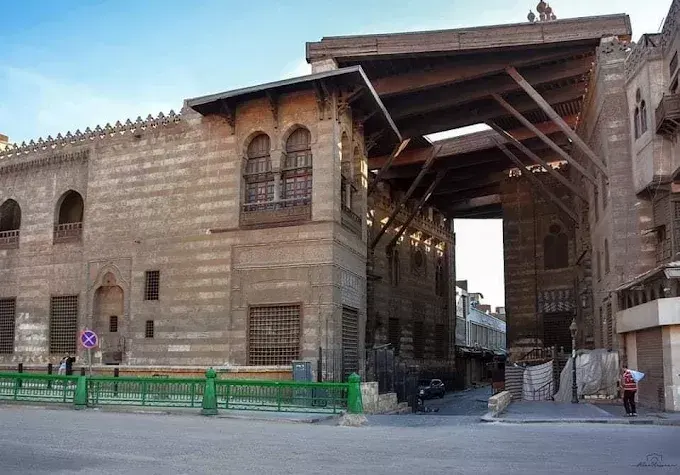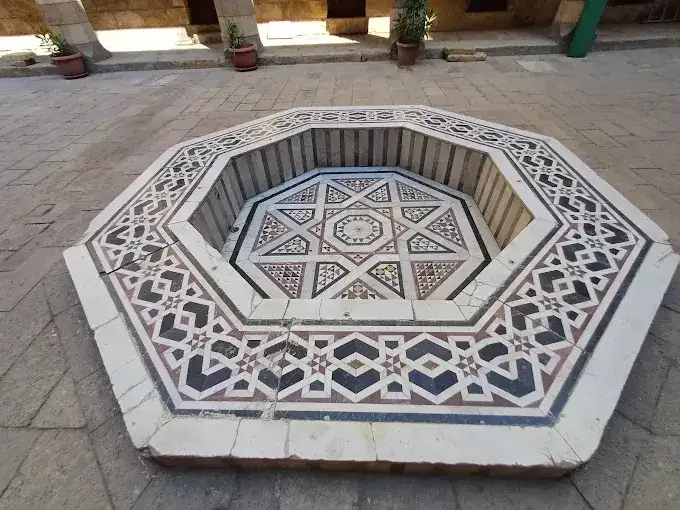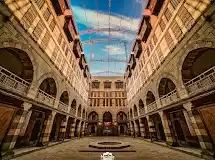El Ghorya | Attractions in Cairo Egypt

Picture this: You're standing on Al-Muizz Street in Islamic Cairo when suddenly a whirling dancer in colorful skirts spins past you, moving so fast they blur into a rainbow. Welcome to El Ghorya—where a 500-year-old Mamluk complex hosts one of Cairo's most mesmerizing cultural performances.
El Ghorya isn't just another historic site. It's a living, breathing cultural center where ancient architecture meets modern artistic expression. Built by Sultan Qansuh Al-Ghuri in the early 16th century, this magnificent complex has transformed from a medieval marketplace into Cairo's premier venue for traditional Egyptian performances.
What Makes El Ghorya Special?
A Complex with Multiple Personalities
El Ghorya (also spelled Al-Ghouriya or Ghouriyya) actually consists of several buildings straddling Al-Muizz Street:
On the Western Side:
- Mosque-Madrasa with one of Cairo's tallest minarets
- Prayer hall that once supported the city's largest dome
- Courtyard perfect for Friday prayers
On the Eastern Side:
- Sultan Al-Ghuri's mausoleum (though he was never buried there!)
- Sabil (free water dispensary for the public)
- Administrative offices
Just East, the Star Attraction:
- Wikala Al-Ghuri (the caravanserai/inn)
- Now restored as an arts center
- Home to the famous Tanoura dance performances
Why You've Probably Never Heard of It
Despite its magnificence, El Ghorya flies under the tourist radar. Here's the truth: While everyone flocks to Khan el-Khalili bazaar just minutes away, El Ghorya offers something far more special—authentic cultural experiences without the overwhelming crowds.
The Fascinating Story of Sultan Al-Ghuri
A Warrior King's Ambitious Vision
Sultan Qansuh Al-Ghuri ruled Egypt from 1501 to 1516 AD, representing the twilight of Mamluk power. At 60 years old when he took the throne, Al-Ghuri was no ordinary sultan.
His Achievements:
- Built some of Cairo's most impressive Mamluk architecture
- Established charitable institutions across the city
- Fought valiantly against the rising Ottoman threat
- Created this multi-functional complex serving religious, commercial, and social needs
The Tragic End
In 1516 AD, Sultan Al-Ghuri died fighting the Ottoman Empire at the Battle of Marj Dabiq in northern Syria. He was 75 years old—remarkable for his era!
The Irony: Despite building an elaborate mausoleum for himself in El Ghorya complex, his body was never recovered from the battlefield. His tomb remains empty to this day—a haunting reminder of how even powerful rulers can't control their final fate.
The Ottoman victory at Marj Dabiq ended Mamluk rule in Egypt, making El Ghorya one of the last great monuments of the Mamluk era.

- Al-Muizz Street, south of Al-Azhar Street in Islamic Cairo
- 5-minute walk from Khan el-Khalili bazaar
- Near Al-Azhar Mosque and Bab Zuweila gate
- Accessible via Ataba or Al-Azhar metro stations
- Taxi drivers know "Wikala Al-Ghuri" or "Al-Ghouriya"
- Monday, Wednesday, and Saturday evenings
- Show starts approximately 7:30-8:00 PM
- Duration about 60 minutes
- Times may change during Ramadan
- Check current schedule locally before visiting
Exploring the El Ghorya Complex
The Mosque-Madrasa: Architectural Marvel
The mosque on the western side showcases late Mamluk architectural genius:
The Minaret: Originally constructed of stone, later rebuilt with bricks, this minaret soars so high it's visible from considerable distances. It ranks among Old Cairo's tallest!
The Dome Dilemma: The ceiling once supported Cairo's largest dome—an engineering feat! However, it kept collapsing (perhaps the design was too ambitious?). Eventually, architects replaced it with a simple flat wooden roof that remains today.
Interior Features:
- Exquisite detailed carvings throughout the courtyard
- Mihrab facing Mecca (the Qibla)
- Separate women's prayer area (a later addition)
- Open-air courtyard allowing natural light
Still Active: Unlike many historic mosques turned into museums, El Ghorya mosque still functions for prayers, keeping its spiritual purpose alive after 500+ years.
The Mausoleum: An Empty Tomb's Story
Cross Al-Muizz Street to find Sultan Al-Ghuri's intended final resting place.
The mausoleum's architecture reflects Al-Ghuri's status and wealth. Intricate stone carvings, soaring ceilings, and beautiful Islamic geometric patterns adorn every surface.
Why Visit an Empty Tomb?
- The architecture itself is breathtaking
- It tells the poignant story of a sultan's unfulfilled plans
- Less crowded than other Cairo attractions
- Perfect for photography with dramatic lighting
The Sabil: Charitable Architecture
The sabil (water dispensary) represents Islamic charitable tradition. In medieval Cairo, these structures provided free clean water to the public—essential in a desert city.
Al-Ghuri's sabil demonstrates how Islamic architecture combined functionality with beauty. Even a simple water station became an artistic statement!
Wikala Al-Ghuri: From Caravanserai to Cultural Hub
What's a Wikala Anyway?
Think of a wikala (also spelled wekalet or caravanserai) as a medieval combination of:
- Hotel for traveling merchants
- Warehouse for goods
- Trading post
- Social center
Built in 1504-1505 AD, Wikala Al-Ghuri is one of Cairo's best-preserved examples of this building type.
The Original Design
Ground Floor:
Stalls serving as shops for traveling merchants
Storage vaults (alveoli) for valuable goods
Secure areas for merchandise
Upper Four Floors:
Modular rooms serving as lodges for merchants
Storage space for personal belongings
Common areas for socializing
The Courtyard:
Open rectangular space at the center
Where trading transactions occurred
Natural light and ventilation for the entire building
Architectural Masterpieces
The wikala showcases late Mamluk craftsmanship at its finest:
Woodwork Wonders: Intricate mashrabiya (turned wood screens) cover windows overlooking both the courtyard and street facades. These
aren't just decorative—they provide privacy, shade, and natural air conditioning!
Stone Carving Excellence: Every surface features detailed Islamic geometric patterns, calligraphy, and floral motifs.
Sultan's Rank (Emblem): Al-Ghuri's personal symbol appears throughout, marking this as a royal project.
The Modern Transformation
In the late 20th century, Egyptian authorities brilliantly restored Wikala Al-Ghuri and repurposed it:
Today It Serves As:
- Performance venue for traditional arts
- Artists' ateliers (workshops/studios)
- Exhibition space for contemporary Egyptian artists
- Cultural center promoting Egyptian heritage
- Craft shops in the former stables
The Restoration Success: The project preserved historical authenticity while making the space functional for modern use—a model for heritage conservation!

The Tanoura Show: El Ghorya's Star Attraction
What is Tanoura?
Tanoura (also spelled Tannoura) is Egypt's version of the whirling dervish tradition—a Sufi spiritual practice turned mesmerizing performance art.
What Happens:
- Dancers in vibrantly colored, multi-layered skirts spin continuously
- The spinning represents spiritual journeying and connection with the divine
- Musicians play traditional instruments creating hypnotic rhythms
- Dancers sometimes spin with LED lights or fire for dramatic effect
- The performance lasts about 60 minutes
Why It's Magical
Visual Spectacle: As dancers spin faster, their skirts billow out into perfect circles of color. Some dancers wear skirts with patterns that create optical illusions when spinning!
Spiritual Dimension: While presented as cultural entertainment, Tanoura dancing has deep spiritual roots in Sufi mysticism. The continuous spinning symbolizes the rotation of planets and the spiritual seeker's journey.
Acoustic Perfection: The wikala's courtyard creates natural acoustics. Traditional instruments—drums, flutes, and cymbals—fill the space with soul-stirring music.
Performance Schedule & Tickets
When:
- Monday, Wednesday, and Saturday evenings
- Shows typically start around 7:30-8:00 PM (but check current times!)
- Times may change during Ramadan
Tickets:
Very affordable compared to tourist shows
Entry to the wikala itself is often free
Tanoura show requires a ticket
Pro tip: Online booking can be problematic—buy tickets in person at the venue
Booking Smart:
- Arrive 30-45 minutes early to secure good seats
- The courtyard fills up quickly
- Front rows give best views but prepare for neck strain from looking up!
- Shows can sell out, especially weekends
What Visitors Say
"The Tanoura show is a highlight, offering a mesmerizing display of Egyptian culture and spirituality."
"This was the most authentic tour I had in Cairo...you ride a time machine to see how Egyptian life was like hundreds of years ago."
"Breathtaking. Words don't do it justice."
Practical Information for Visiting El Ghorya
Location & Getting There
Address: Al-Muizz Street, just south of Al-Azhar Street, Islamic Cairo
Nearby Landmarks:
- Khan el-Khalili bazaar (5-minute walk)
- Al-Azhar Mosque (3-minute walk)
- Bab Zuweila gate (10-minute walk south)
Transportation:
Metro: Get off at Ataba or Al-Azhar stations, then taxi/walk
Taxi: Tell drivers "Wikala Al-Ghuri" or "Al-Ghouriya, Al-Muizz Street"
Walking: If exploring Islamic Cairo, easily walkable from other sites
Parking: Limited street parking; better to use taxi/rideshare
Opening Hours
Wikala/Arts Center:
- Generally open daylight hours for exploration
- Check locally for current hours
Tanoura Performances:
- Monday, Wednesday, Saturday evenings
- Approximately 7:30-8:00 PM start
- Duration: About 1 hour
Costs
Wikala Entry: Often free to explore Tanoura Show: Modest ticket price (excellent value!) Photography: Usually allowed but confirm
What to Wear
For Mosque Areas:
- Modest clothing (cover shoulders, knees)
- Women should bring scarves for head covering
- Remove shoes before entering prayer areas
For Tanoura Show:
- Casual clothing fine
- Comfortable seating on floor or benches
- Bring cushion if you have back issues!
Best Time to Visit
Avoid Crowds:
- Weekday afternoons for exploring the complex
- Monday shows less crowded than Saturday
Best Experience:
- Combine afternoon exploration with evening Tanoura show
- Golden hour (late afternoon) offers best photography light

- Monday, Wednesday, and Saturday evenings
- Show starts approximately 7:30-8:00 PM
- Duration about 60 minutes
- Times may change during Ramadan
- Check current schedule locally before visiting
- Wikala Al-Ghuri entry often free for exploration
- Tanoura show tickets are modestly priced
- Excellent value compared to tourist shows
- Buy tickets in person at venue (online booking unreliable)
- Arrive 30-45 minutes early for good seats
Customize Your Dream Vacation!
Get in touch with our local experts for an unforgettable journey.
Plan Your Trip
Experience El Ghorya Like Never Before
Prepare for Magic Before You Arrive! Research Mamluk history basics and learn a few Arabic phrases—locals light up when tourists try their language! Understanding Sufism transforms the Tanoura show from entertainment into spiritual journey. During your visit, don't just look—engage! Ask guides why Sultan Al-Ghuri's tomb sits empty (the answer is fascinating).
Get close to the mashrabiya screens and marvel at woodwork so intricate it seems impossible. After the hypnotic evening show, sip sweet mint tea at a local café while discussing what the spinning meant to you, then discover Al-Muizz Street's enchanting nighttime glow.
Your Perfect Islamic Cairo Adventure
Morning to midnight, this day delivers pure Cairo magic! Start at Al-Azhar Mosque, then walk Al-Muizz Street—the world's greatest open-air Islamic museum. Stop at Qalawun Complex before lunch at a bustling restaurant near Khan el-Khalili. Spend your afternoon lost in Khan el-Khalili's maze of treasures, then tour El Ghorya's stunning mosque and mausoleum as golden afternoon light streams through ancient windows.
Evening brings the main event: the mesmerizing Tanoura show at Wikala Al-Ghuri. Everything you need sits within minutes—Khan el-Khalili, Al-Azhar, and the Tent-makers' bazaar are five-minute walks, while Sultan Hassan's towering grandeur and medieval Bab Zuweila gate await just ten minutes away.
Where History Comes Alive Today
This isn't a dead museum—it's a living, breathing cultural powerhouse! Egypt brilliantly transformed a deteriorating Mamluk masterpiece into a thriving hub where artists create, performers spin, and traditions survive. Ticket sales fund restoration, local craftspeople earn livelihoods, and visitors experience heritage instead of just reading about it.
As the last major monument before the Ottomans conquered Cairo in 1517, El Ghorya captures the final glory days when Cairo's wealth and sophistication matched anything in Europe. The complex proves medieval Cairo understood what modern cities are relearning—integrate worship, commerce, art, and community in one magnificent space.
Insider Secrets from Those Who Know
Smart visitors arrive 30-45 minutes early for the Tanoura show—trust us on this! Skip the back rows if you want amazing photos, and forget online booking (it's notoriously unreliable). Bring small Egyptian bills and stay after the performance when performers are relaxed and happy to chat.
The real magic happens when you explore the neighborhood afterwards—don't rush away! Photographers, listen up: mashrabiya screens create jaw-dropping light patterns in late afternoon, and slow shutter speeds turn spinning dervishes into artistic motion blur. The minaret photographs best from a distance where you capture its full soaring height without awkward angles.
Questions That Haunt and Inspire
Stand in that empty tomb and feel history's weight. Sultan Al-Ghuri built his eternal resting place, expecting to sleep here forever—but he died in distant battle and his body never returned. What does this empty monument say about our plans versus fate's plans?
Watch Tanoura dancers spin for an entire hour—try spinning yourself for just thirty seconds and you'll appreciate their superhuman skill! In the wikala courtyard, close your eyes and imagine: you're a 16th-century spice merchant, exhausted after weeks crossing endless desert, finally reaching Cairo's safety. Your camels carry precious cargo—Indian textiles, Yemeni frankincense, mysterious goods from lands even farther east. What deals will you strike in this bustling caravanserai where a dozen languages echo off ancient stone?
- Built 1503-1505 AD by Sultan Qansuh Al-Ghuri
- Last major Mamluk monument before Ottoman conquest
- Sultan died in battle 1516 AD, never buried in his mausoleum
- Complex includes mosque, mausoleum, sabil, and wikala
- Restored late 20th century as cultural arts center
- Yes, the mosque is still active for prayers
- Open to visitors outside prayer times
- Modest dress required (cover shoulders, knees)
- Women need headscarves
- Remove shoes before entering
- Respectful behavior expected in active worship space
- Best-preserved caravanserai in Cairo
- Built 1504-1505 AD for traveling merchants
- Features exquisite mashrabiya (wooden screens)
- Intricate stone carving and Islamic geometric patterns
- Four-story structure with courtyard
- Example of Mamluk commercial architecture at its finest
- Mosque and mausoleum exploration: 30-45 minutes
- Wikala browsing and shopping: 30-60 minutes
- Tanoura performance: 60 minutes
- Total recommended: 2-3 hours including show
- Combine with Al-Muizz Street walking tour
- Best visited late afternoon through evening
- Khan el-Khalili bazaar (5-minute walk)
- Al-Azhar Mosque (3 minutes)
- Bab Zuweila gate (10 minutes)
- Sultan Hassan Mosque (15 minutes)
- Qalawun Complex on Al-Muizz Street
- Tent-makers' bazaar (Khayamiya)
- Perfect for full-day Islamic Cairo exploration

























